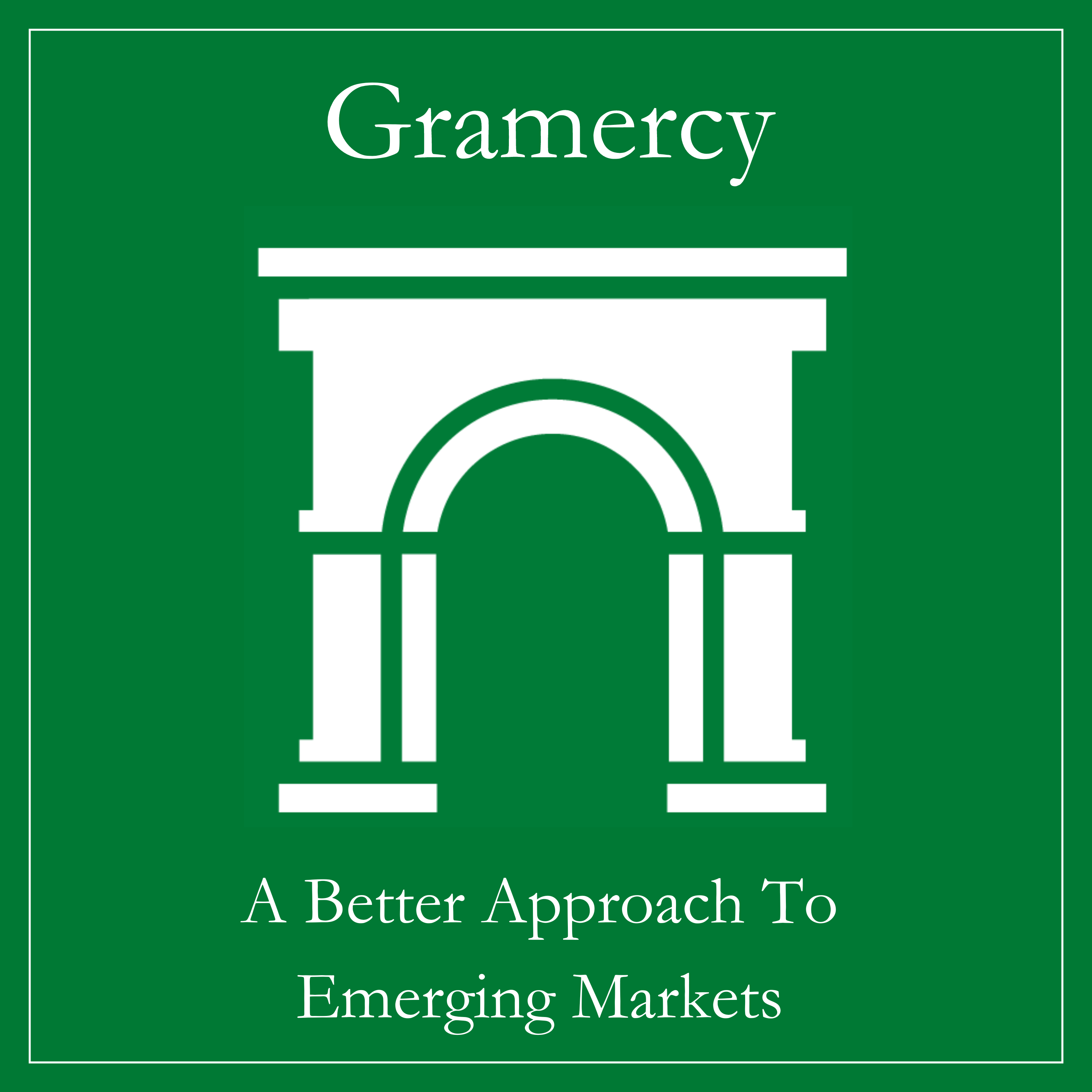Contents
Market Overview
Macro Review
Markets continued to digest headlines generated by the political crisis in France and political noise in Europe more broadly. Weak French PMI data on Friday only amplified market concerns around the political uncertainty in the Eurozone’s second largest economy ahead of the snap parliamentary elections on June 30th called by President Macron. The EUR lost ground against a resurgent USD, breaking below 1.07 for the first time since April. In the UK, as expected, the Bank of England (BoE) held interest rates unchanged ahead of the UK’s general election on July 4th. However, markets interpreted the BoE’s hold as dovish, which supported the view that a cut may be coming in August. In the meantime, the Swiss National Bank (SNB) contributed to dovish sentiment, cutting its policy rate to 1.25% from 1.50% against consensus expectations. This was the second consecutive easing by the SNB that in March delivered the first rate cut by a developed market central bank in the current cycle; the EUR gained against the CHF as a result. Meanwhile in the U.S., Federal Reserve Bank of Philadelphia’s President Patrick Harker reiterated earlier in the week that one interest rate cut by the Fed would be appropriate for this year, despite last month’s softer than expected CPI print. In China, May macro data came in mixed and the PBoC kept rates on hold but signaled potential for refinement to monetary policy. In EM, highlights this week included Brazil’s Central Bank decision to pause its easing cycle in an unanimous result, keeping the SELIC rate at 10.5% and the IMF’s report on Argentina emphasizing better-than-expected results on fiscal accounts, reserve accumulation and inflation.
EM Credit Update
Emerging markets sovereign credit (cash bonds) ended the week -0.1% with spreads flat. Sovereign outperformers were Honduras, Tunisia, and Poland, while Gabon, Kenya, and Malaysia underperformed. Corporate credit was flat at the index level with spreads 2bps tighter. EM local debt outperformed this week, recovering by 0.5%.
The Week Ahead
Inflation indicators will be the highlight next week as investors watch releases across key economies next Friday. These include the PCE in the U.S., the Fed’s favorite inflation measure, flash CPIs in several European economies, as well as the Tokyo CPI in Japan. From central banks, there will be the BoJ’s summary of opinions from the June meeting, the ECB’s consumer expectations survey and a rates decision from Sweden’s Riksbank. Across EM, investors will expect MPC meetings in Turkey (consensus on hold at 50%), the Czech Republic (-25bps to 5%), Mexico (on hold at 11%), and Colombia (-50bps to 11.25%). Other highlights include Brazil’s consumer prices for June and South Africa’s PPI inflation for May.
Highlights from emerging markets discussed below: Brazil’s Central Bank (BCB) pauses its easing cycle in a unanimous decision, defying calls by the Lula Administration for lower rates, China May macro data remains mixed; rates on hold with potential for refinement to monetary policy, and Argentina IMF report references contours for next stage of policy; solid May fiscal and trade prints.
Fixed Income
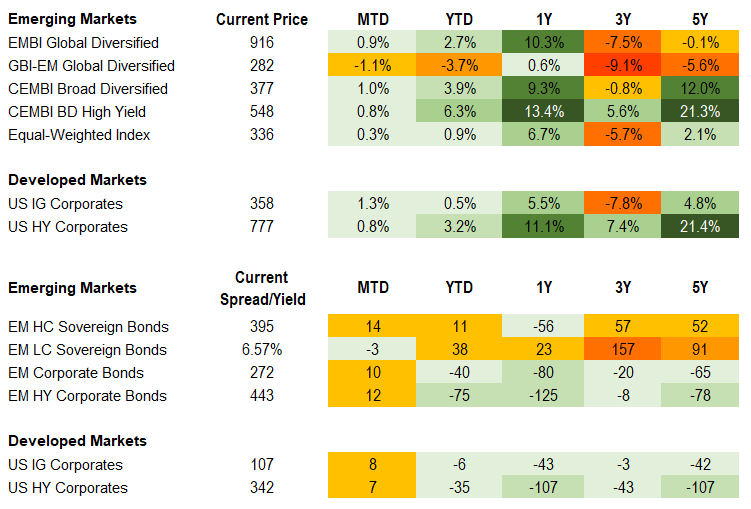
Equities
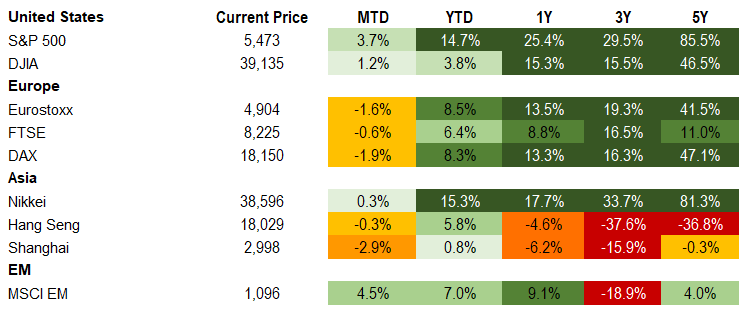
Commodities

Source for data tables: Bloomberg, JPMorgan, Gramercy. EM Fixed Income is represented by the following JPMorgan Indicies: EMBI Global, GBI-EM Global Diversified, CEMBI Broad Diversified and CEMBI Broad High Yield. DM Fixed Income is represented by the JPMorgan JULI Total Return Index and Domestic High Yield Index. Fixed Income, Equity and Commodity data is as of June 21, 2024 (early-afternoon).
Emerging Markets Weekly Highlights
Brazil’s Central Bank (BCB) pauses its easing cycle in a unanimous decision, defying calls by the Lula Administration for lower rates
Event: This week, the BCB held its main interest rate (SELIC) at 10.5%, pausing the monetary policy easing cycle that began in August 2023 which saw 325 bps of cumulative rate cuts delivered in seven of the nine previous policy-setting meetings.
Gramercy Commentary: In addition to the actual policy decision, markets were focused on the vote split among the nine members of the COPOM, the BCB’s policy-setting body. For context, last month’s 25bps rate cut to 10.5% came in a narrow 5:4 decision split strictly across the lines of COPOM members appointed by former President Bolsonaro (the five votes in the majority) versus those appointed by President Lula (the four votes who were in favor of a deeper 50bps cut back in May). Markets interpreted this as a serious PR blunder by the BCB and that they might be signaling a concerning politically motivated dichotomy in the COPOM mid-way through the Lula Administration’s mandate and ahead of BCB Governor Roberto Campos Neto’s scheduled departure at the end of the year. This, together with external top-down factors (Fed hawkishness/strong USD) and renewed market concerns around Brazil’s perennial quest for fiscal consolidation, has put significant pressure on the BRL and local currency sovereign bonds in recent weeks. Now, the COPOM’s unanimous decision to hold the SELIC rate amid rising medium-term inflation expectations as shown by the BCB’s influential “focus survey” of market participants should reassure investors that monetary policy decisions remain credible and driven by objective economic analysis rather than political duress. The BRL gained upon the BCB keeping rates on hold. For his part, President Lula decried the decision, calling Brazil’s interest rates “excessively high”, but added that he did not want to influence the BCB’s decisions, which we interpret as a constructive nod to markets by the President, well-known for his pragmatic approach to economic policy management.
China May macro data remains mixed; rates on hold with potential for refinement to monetary policy
Event: Soft credit growth (M1 contraction of 4.2% y/y vs. -1.7% y/y consensus), industrial production (5.6% y/y vs. 6.2% y/y consensus), and fixed asset investment (4.0% y/y vs. 4.2% y/y consensus) data were offset by a beat on retail sales (3.7% y/y vs. 3.0% y/y consensus). Meanwhile, the PBoC kept rates unchanged while comments from Governor Pan suggested the potential for possible adjustments to the monetary framework, including broadening the definition of money supply, narrowing the interest rate corridor and reviewing how the PBoC could conduct government bond trading.
Gramercy Commentary: At this juncture, the data continues to back continuation of an incremental approach to policy support and an annual growth rate of around 5% (market consensus of 4.9%). The market will keep its focus on high frequency data for June as well as look to the third plenum on reform in July for potential clarity on the evolution of policy support going forward. We see continued room for incrementally weaker CNY fixings in the context of a stronger dollar.
Argentina IMF report references contours for next stage of policy; solid May fiscal and trade prints
Event: The IMF staff report on the 8th review of the existing EFF program released earlier this week emphasized the better-than-expected results on fiscal accounts, reserve accumulation and inflation. Macroeconomic assumptions were adjusted moderately with 2024 growth at -3.5%, primary fiscal surplus of 1.7% of GDP and inflation at the end of the year of 139.7% y/y. The report also references the transition towards a regime of currency competition where the BCRA would pursue real rates and a more flexible FX rate. Meanwhile, the May fiscal balance remained in positive territory bringing the YTD headline surplus to 0.4 % of GDP while the trade balance printed at $2.7bn or 0.8% of GDP on a past 12-month basis.
Gramercy Commentary: We see the constructive IMF assessment as a solid basis for negotiations of a new program, although commitment and execution of policy evolution in 2H will be key. The latest data continues to underscore the government’s successful policies thus far. However, the current monetary framework and reserve accumulation has begun to face limitations, suggesting needed adjustment in the coming months to cement the disinflation path and avoid rebuilding of macroeconomic imbalances.
Emerging Markets Technicals
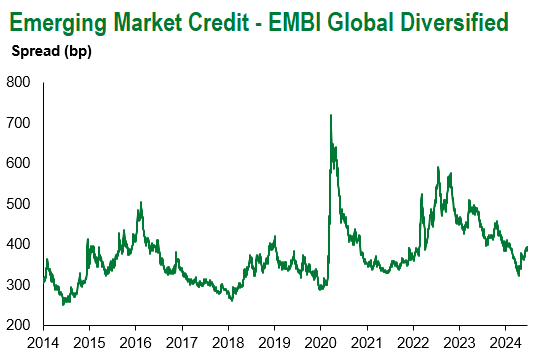
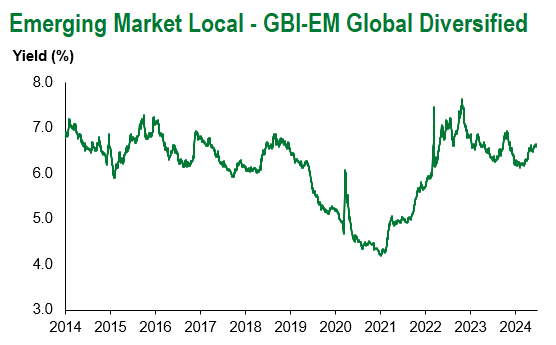
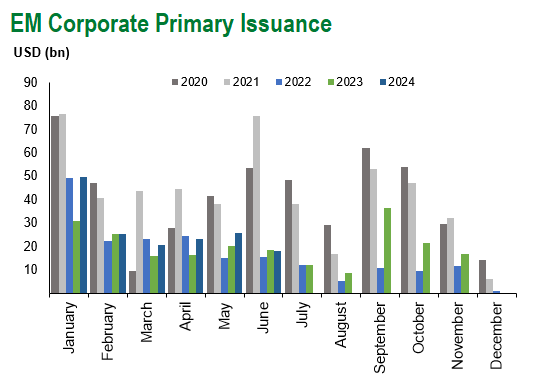
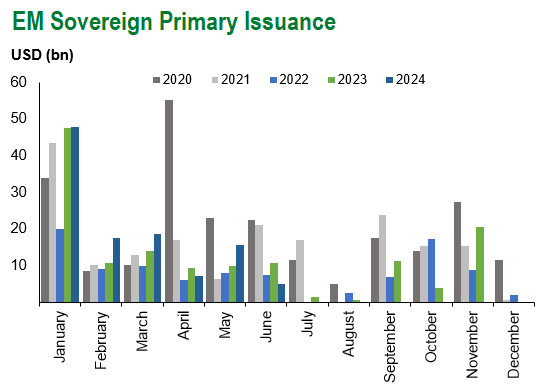
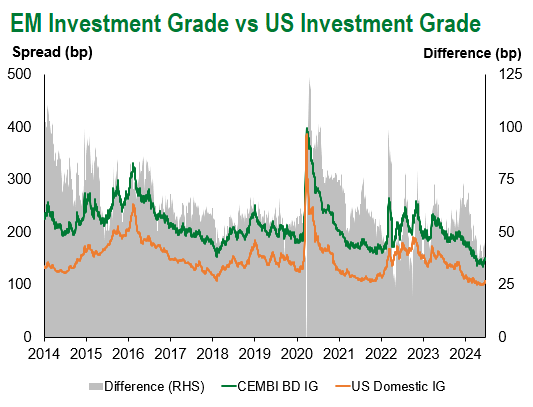
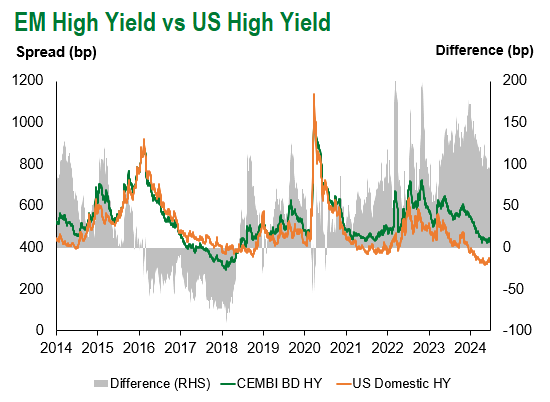

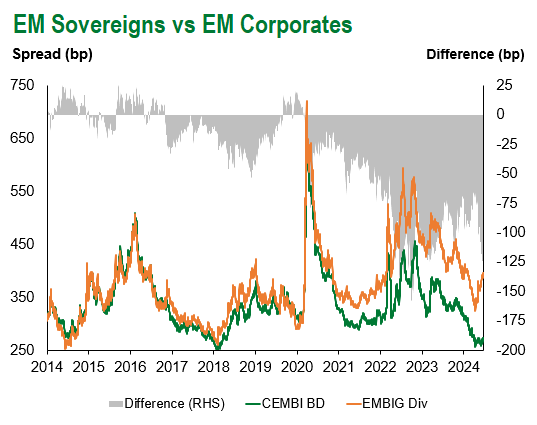
Emerging Markets Flows
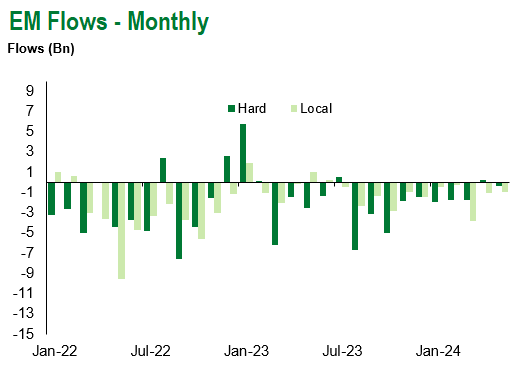
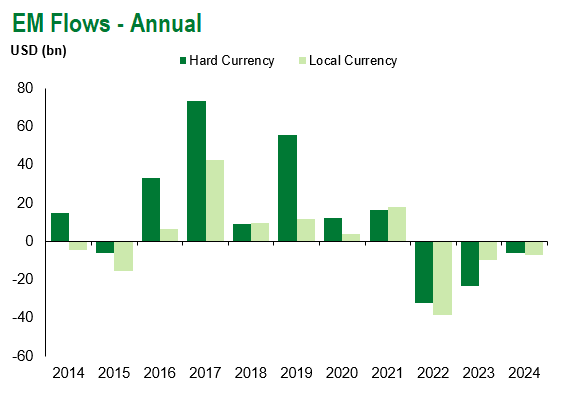
Source for graphs: Bloomberg, JPMorgan, Gramercy. As of June 21, 2024.
For questions, please contact:
Kathryn Exum, CFA ESG, Director, Co-Head of Sovereign Research, [email protected]
Petar Atanasov, Director, Co-Head of Sovereign Research, [email protected]
James Barry, Director, Deputy Portfolio Manager, [email protected]
This document is for informational purposes only. The information presented is not intended to be relied upon as a forecast, research or investment advice, and is not a recommendation, offer or solicitation to buy or sell any securities or to adopt any investment strategy. Gramercy may have current investment positions in the securities or sovereigns mentioned above. The information and opinions contained in this paper are as of the date of initial publication, derived from proprietary and nonproprietary sources deemed by Gramercy to be reliable, are not necessarily all-inclusive and are not guaranteed as to accuracy. This paper may contain “forward-looking” information that is not purely historical in nature. Such information may include, among other things, projections and forecasts. There is no guarantee that any forecasts made will come to pass. Reliance upon information in this paper is at the sole discretion of the reader. You should not rely on this presentation as the basis upon which to make an investment decision. Investment involves risk. There can be no assurance that investment objectives will be achieved. Investors must be prepared to bear the risk of a total loss of their investment. These risks are often heightened for investments in emerging/developing markets or smaller capital markets. International investing involves risks, including risks related to foreign currency, limited liquidity, less government regulation, and the possibility of substantial volatility due to adverse political, economic or other developments. References to any indices are for informational and general comparative purposes only. The performance data of various indices mentioned in this update are updated and released on a periodic basis before finalization. The performance data of various indices presented herein was current as of the date of the presentation. Please refer to data returns of the separate indices if you desire additional or updated information. Indices are unmanaged, and their performance results do not reflect the impact of fees, expenses, or taxes that may be incurred through an investment with Gramercy. Returns for indices assume dividend reinvestment. An investment cannot be made directly in an index. Accordingly, comparing results shown to those of such indices may be of limited use. The information provided herein is neither tax nor legal advice. Investors should speak to their tax professional for specific information regarding their tax situation.
